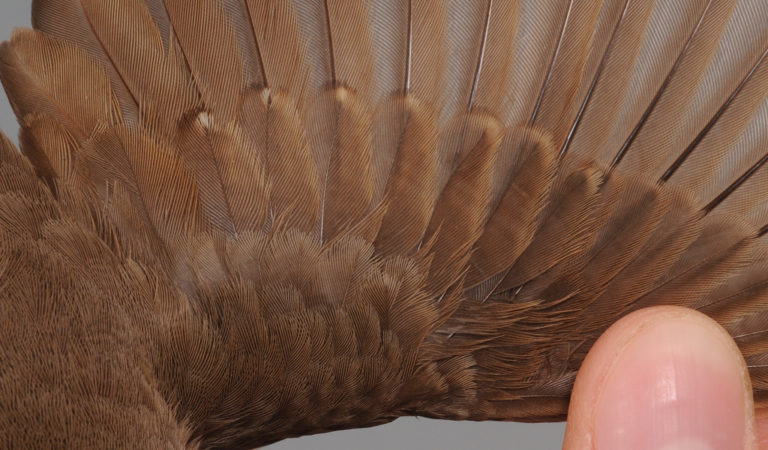

Thrush Nightingale
AGE – BEST CRITERIA:
Autumn criterias are still applicable, though 2cy are more affected to wear during the winter than adult. In 2cy, moult contrast is present in GC, most often in the central part of the arm. Adult birds show a uniform and freshly moulted plumage.
2cy:
Most birds included 4-6 inner GC in the post-juvenile moult. Juvenile outer GC show a slightly more rusty hue on the outer vane (but note that a rusty hue is present also in post-juvenile/post-breeding GC, but with a slightly more olive-brown colour component) and generally diffuse pale rusty-buff tips. Difference in wear between juvenile and post-juvenile GC is now more obvious than in autumn.
Juvenile PC are often slightly less dense, more worn and more loose/frayed than in adult, but difference is often difficult to detect.
Juvenile RR are generally slightly more worn, narrow and more pointed, but difficult birds are often seen.
Juvenile TT are often slightly narrower and more pointed, sometimes showing a pale buff tip. A weak contrast is often seen towards the post-juvenile inner GC, the latter being less rusty, more olive-brown. A few birds show a similar moult contrast within the TT.
3cy+:
Whole plumage uniform, lacking moult contrasts.
GC are uniformly olive-brown with no pale tips (but note that the MC are often even more olive, which may lead to thoughts of a moult contrast).
PC are slightly more dense, in better condition and slightly less rusty.
RR are generally slightly broader, more blunt tipped and often in better condition.

2cy May. GC1-7 are juvenile with a rusty hue and rather large pale buffish tip (which may be lacking due to wear). Inner post-juvenile GC8-10 are in better condition and lack pale tips. In this individual the post-juvenile GC are almost as rusty as the juvenile outer ones, but in most birds the newly aquired GC are slightly less rusty, and more cold olive brown. [2KS80364]
More Luscinia luscinia:
Ringers’ DigiGuide is sponsored by:
Hemsidan producerad i samarbete med
BirdLife Sverige